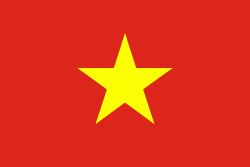Lao Cai province (Tỉnh Lào Cai)
Lào Cai and Sa Pa are two important cities within the province at the border with China; the former is well known as key trading post and the latter is hill station famous for tourism, in the Northwest region of Vietnam. Lào Cai is also the capital of Lào Cai province and shares border with the city of Hekou, in the Yunnan province of Southwest China. This border town was closed after the 1979 war with China, since reopened in 1993, has become a major tourist centre between Hanoi, Sa Pa and Kunming (China). Sa Pa is notable as a hill resort and market centre for the local ethnic Hmong, including the Red, Black, Green and Flower Hmong. Located across the Muong Hoa Valley from Vietnam's highest mountain, Fansipan, the city is sometimes referred to as the "queen of mountains".
Lào Cai has many historical sites, natural caves and produces agricultural specialties such as Bắc Hà plums.
In a 1929 survey conducted in the area, the vegetation (flora) and fauna (mammals) recorded by the French biologist Delacour who accompanied Theodore Roosevelt were unique to the region in northern Vietnam.
The name "Lao-Kay" has been used by the French since the colonial era in their writing, pronounced as "Lào Cai" by the Vietnamese. The latter became official usage and spelling after November 1950.
The origin of the province's name is unclear and there are several explanations. The area in the ward of Cốc Lếu was the site of an old commercial district that developed into a market town. Because of this it was called Lão Nhai (老街, literally Phố Cũ, Old Town), in Hmong language it is pronounced as "Lao Cai". After this a new market town was developed and named Tân Nhai (新街, today Phố Mới, New Town). The word Lào Cai is sourced to "Lao Kai" which appeared as Jean Dupuis led a naval expedition up the Red River and in 1879 published the Map of Tonkin, in which the location was marked as "Lao-kai, residence du Chef des Pavillone noirs" (residence of the Head of Black Flag Army). According to Professor Đào Duy Anh, it derives from the word "Lão Nhai". While making maps, the French wrote it as "Lao-Kay" and this word was used by them in documents. When reading, the Vietnamese pronounced it Lào Cai and this has persisted since.
Map - Lao Cai province (Tỉnh Lào Cai)
Map
Country - Vietnam
 |
 |
| Flag of Vietnam | |
Vietnam was inhabited by the Paleolithic age, with states established in the first millennium BC on the Red River Delta in modern-day northern Vietnam. The Han dynasty annexed Northern and Central Vietnam under Chinese rule from 111 BC, until the first dynasty emerged in 939. Successive monarchical dynasties absorbed Chinese influences through Confucianism and Buddhism, and expanded southward to the Mekong Delta, conquering Champa. The Nguyễn—the last imperial dynasty—surrendered to France in 1883. Following the August Revolution, the nationalist Viet Minh under the leadership of communist revolutionary Ho Chi Minh proclaimed independence from France in 1945.
Currency / Language
| ISO | Currency | Symbol | Significant figures |
|---|---|---|---|
| VND | Vietnamese đồng | ₫ | 0 |
| ISO | Language |
|---|---|
| KM | Central Khmer language |
| ZH | Chinese language |
| EN | English language |
| FR | French language |
| VI | Vietnamese language |
















